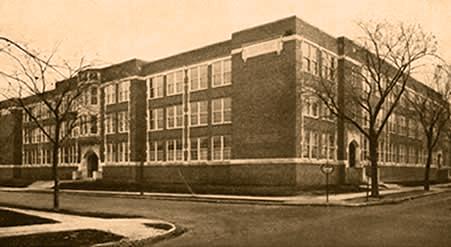
Lincoln Community School is poised to become a park-like neighborhood gateway and oasis with help from University-community partners and residents

George and Beverly Roberts, along with some of their neighbors, had already written to the Minneapolis school board expressing concern over the condition of North Minneapolis’ Lincoln Community School playground when, much to their happy surprise, they attended Community Day at the University of Minnesota Robert J. Jones Urban Research and Outreach Engagement Center (UROC) and found staff there were working on the issue too.
“We were walking around and we saw a display board on University educator Sara Axtell’s desk explaining how UROC was already talking with other service organizations on the Northside about how the playground could be made safer and more inviting so the community could use it,” George Roberts recalls. A resident of North Minneapolis since 1970, Roberts was an English teacher at North Community High School for many years. Now retired, he and Beverly own and run Homewood Studios, a gallery and artist workspace on Plymouth Avenue.
They and their neighbors love where they live. So after watching the Lincoln School playground fall into disrepair after the school was closed by the district and rented out, they came together to try to revitalize the site, which they see as “the new heart of our community,” Roberts says. “We’d like to create a place where education and health awareness can happen, and we want to give the children in our community a place that they deserve, not an ugly field that tells them they are not important.”
UROC and other community partners agree on the need to redesign the playground to create an inviting, safe green space for children and others to enjoy. Axtell, UROC’s community-campus health liaison, and others began work on this project following the release of the North Minneapolis Youth Violence Prevention Working Group’s research into youth violence in North Minneapolis in 2014.
A collaboration between UROC; The City, Inc.; Juvenile Justice Advisory Committee, the Institute on Domestic Violence in the African American Community, Phyllis Wheatley Community Center; the University of Minnesota Program in Health Disparities Research; and the University of Minnesota Center for Health Equity, the working group’s goal was to gather information that could be used to formulate successful youth violence interventions.
Interviews with youth and adults conducted during the project revealed consistent concerns about safety. And among the working groups many findings was the need to establish safe and appealing areas for youth to spend their time. The Lincoln Community School playground, it seemed, would be a perfect spot to create such a place.
So with the mantra “listen to the neighborhood” in mind, the Lincoln Playground Working Group, which includes the Northside Residents Redevelopment Council (NRRC), community members, the Mississippi Watershed Management Organization, Hennepin County’s Penn Avenue Community Works Project and UROC, has been meeting for months to talk about ideas and funding.
Bruce Jacobson, a local landscape architect, has helped facilitate the group’s initial planning and concept design discussions with support and additional resources from the University of Minnesota through his position as Senior Research Fellow at the College of Design’s Metropolitan Design Center. So far, three public meetings have been held to discuss possible ideas, which include things like a well-lit park-like playground, a multi-purpose building where people could take part in a variety of activities, opportunities for education and art, as well as environmentally friendly infrastructure that reuses and cleans storm water runoff.
Though there is much to be settled on before the project can even be started, Roberts is optimistic about the progress that’s been made so far, particularly since all three of the planning meetings were attended by teenagers from the neighborhood. “They were really excited to be listened to and to be considered an important part of the community, and we have a lot of partners in place who see this as a community health issue” he says. “We could be looking at a 5- to 10-year project, but we hope to have a ribbon cutting soon so we can start to see things come alive there as soon as possible.”